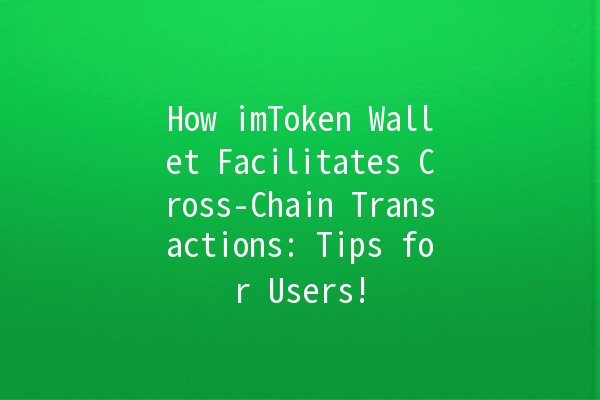In the everevolving landscape of cryptocurrencies, the need for seamless crosschain transactions has become increasingly important. With numerous blockchain networks existing in today's digital economy, users often find themselves wanting to transfer assets between different chains efficiently. This is where the imToken wallet comes into play. This digital wallet not only provides a secure storage option for various cryptocurrencies, but it also enables users to engage in crosschain transactions with relative ease.
Below, we delve into how imToken wallet enhances the experience of executing crosschain transactions, paired with actionable tips to improve your productivity while using this platform.

Crosschain transactions refer to the ability to transfer assets or data across different blockchain networks. This process can often be complex due to the varying protocols and consensus mechanisms that different blockchains employ. Traditional methods of transferring assets across chains typically involved intermediaries that might lead to increased costs and delays.
However, with wallets like imToken, the crosschain transaction process is streamlined. imToken utilizes various technologies, including atomic swaps and blockchain bridges, to facilitate these transactions, ensuring that users can move their assets with minimal friction.
imToken offers a builtin crosschain feature that makes transferring assets between blockchains simple. Users can take advantage of this integrated function without needing to navigate into thirdparty applications.
Example: If you hold Ethereumbased tokens but want to use them on the Binance Smart Chain, simply select the asset in your imToken wallet and initiate a transfer through the crosschain feature. Having everything in one place saves time and reduces the chance of making errors.
Transaction fees can vary significantly across different networks. By keeping an eye on the current network fees associated with each blockchain, you can make informed decisions about when to execute your transactions, thereby saving money.
Example: If you're planning to send Bitcoin through a crosschain bridge, check the current fee rates on both the Bitcoin network and the receiving network. Timing your transaction can yield significant savings, especially during high network congestion.
Consider managing your assets across multiple chains with the help of multichain wallets like imToken. This approach allows you to quickly swap between tokens on different networks, making it easier to take advantage of market opportunities as they arise.
Example: You might find a cryptocurrency project launching on the Polygon network that interests you. With imToken, you can seamlessly switch some of your Ethereum into Polygon, allowing you to participate in token sales or liquidity pools effortlessly.
Crosschain transactions could involve multiple blockchains and protocols, increasing the chances of errors during transfers. Regularly backing up your wallet ensures that you have access to your assets in case of any mishaps.
Example: Set reminders to back up your wallet data at regular intervals, such as weekly or monthly, and store your recovery phrase securely. This habit protects you from potential losses and provides peace of mind when engaging in crosschain transactions.
Engaging with the imToken community can provide insights into best practices, current trends, and useful tools that can enhance your crosschain experience. These discussions often reveal tips and tricks that other users have discovered.
Example: Join forums or social media groups focused on cryptocurrency and imToken discussions. You may find users sharing their experiences with new protocols or strategies to optimize crosschain transactions, giving you the opportunity to learn from their successes and mistakes.
Crosschain transactions allow users to transfer assets across different blockchain networks. They are essential because they enhance liquidity, provide greater flexibility in using assets, and allow users to access opportunities across multiple platforms.
The imToken wallet offers several features that facilitate crosschain transactions, including the ability to conduct atomic swaps and leverage blockchain bridges. Its integrated functionality streamlines the process, allowing users to transfer assets without relying on thirdparty intermediaries.
Yes, risks include potential errors during the asset transfer process, network congestion leading to errors, and the volatility of transaction fees. It is crucial for users to be informed and cautious when executing crosschain transactions.
By monitoring network fees and timing your transactions effectively, you can minimize costs. Also, use network overload information to choose optimal times for transactions, often late at night or on weekends when fewer users are online.
If you face any issues, start by checking the transaction status on the respective block explorer. If it remains unresolved, reach out to the imToken support team or consult community forums for assistance.
Yes, imToken provides robust security features to protect your assets, including private key encryption and biometric authentication. However, users must also adhere to security best practices, such as safeguarding their recovery phrases.
Navigating the world of crosschain transactions can seem daunting, but with the right tools and knowledge, it becomes far more manageable. The imToken wallet stands out as an excellent choice for facilitating these transactions thanks to its innovative features and userfriendly interface.
By applying the productivityenhancing tips mentioned above, users can maximize their experience with imToken and improve their efficiency in crosschain transactions. As the cryptocurrency landscape continues to evolve, staying informed and adaptable will be paramount for any digital asset holder.
Engagement with community discussions, prioritization of wallet security, and keeping abreast of market trends will undoubtedly bolster a user’s confidence in managing their digital assets.